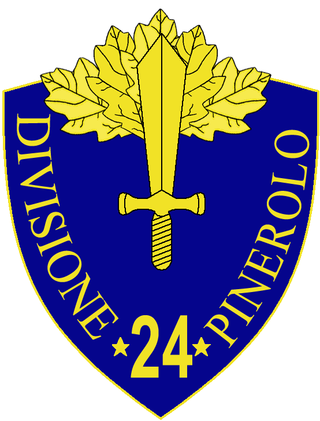
The 24th Infantry Division "Pinerolo" was an infantry division of the Royal Italian Army during World War II. The division was based in Chieti, with its regiments in the Abruzzo region. The division was named for the city of Pinerolo. The division's regimental depots were shared with the 62nd Infantry Division "Marmarica", which was based in Derna in Libya and recruited its men from and trained them in Abruzzo.
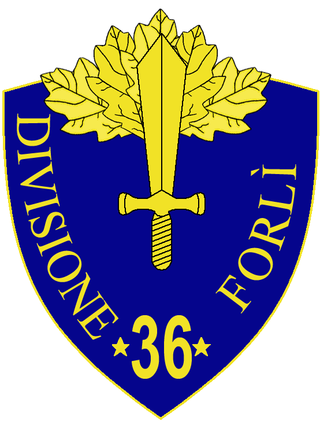
The 36th Infantry Division "Forlì" was a infantry division of the Royal Italian Army during World War II. The Forlì was classified as a mountain infantry division, which meant that the division's artillery was moved by pack mules instead of the horse-drawn carriages of line infantry divisions. Italy's real mountain warfare divisions were the six alpine divisions manned by Alpini mountain troops. The division was formed on 31 March 1939 and named for the city of Forlì. The division was based in Saluzzo and most of its troops were drafted in the surrounding Langhe region in southern Piedmont. The division's two infantry regiments were based in Alba (43rd) and Saluzzo (44th), with the division's artillery regiment also based in Saluzzo.

The 7th Infantry Division "Lupi di Toscana" was an infantry division of the Royal Italian Army during World War II. The Division, with the exception of the 78th Infantry Regiment based in Bergamo, was based in Brescia. Despite its name referencing the region of Tuscany, the division was formed by men from Lombardy, especially from Brescia, Bergamo and the surrounding valleys.

The 11th Infantry Division "Brennero" was a infantry division of the Royal Italian Army during World War II. The Brennero was classified as a mountain infantry division, which meant that the division's artillery was moved by pack mules instead of the horse-drawn carriages of line infantry divisions. Italy's real mountain warfare divisions were the six alpine divisions manned by Alpini mountain troops. The Brennero was named for the Brenner Pass between Italy and Austria. The division was based in the western half of South Tyrol with the division's headquarter in Bolzano.

The 14th Infantry Division "Isonzo" was an infantry division of the Royal Italian Army during World War II. The division was based in Friuli and named for the river Isonzo, along which Italy and Austria-Hungary had fought twelve battles during World War I.

The 37th Infantry Division "Modena" was a infantry division of the Royal Italian Army during World War II. The Modena was classified as a mountain infantry division, which meant that the division's artillery was moved by pack mules instead of the horse-drawn carriages of line infantry divisions. Italy's real mountain warfare divisions were the six alpine divisions manned by Alpini mountain troops. The division was formed on 25 March 1939 with units of the 5th Territorial Division "Imperia" and named for the city of Modena. The division was made up entirely of men from the city of Genoa and the surrounding Liguria region. The division's regimental depots were shared with the 63rd Infantry Division "Cirene", which was based in Benghazi in Libya and recruited its men from and trained them in Liguria.
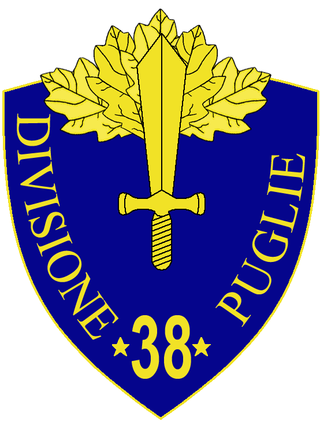
The 38th Infantry Division "Puglie" was a infantry division of the Royal Italian Army during World War II. The Puglie was classified as a mountain infantry division, which meant that the division's artillery was moved by pack mules instead of the horse-drawn carriages of line infantry divisions. Italy's real mountain warfare divisions were the six alpine divisions manned by Alpini mountain troops.
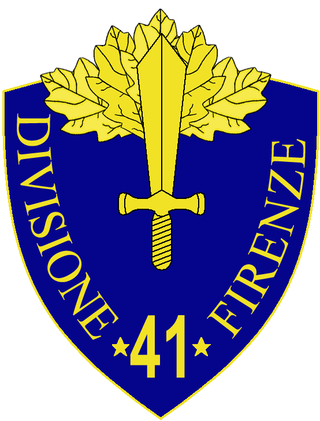
The 41st Infantry Division "Firenze" was an infantry division of the Royal Italian Army during World War II. The Firenze was formed on 15 September 1939 in Florence and named for the city. The division recruited primarily in Tuscany. After the announcement of the Armistice of Cassibile on 8 September 1943 the division resisted German attempts to disbanded it and on 28 September 1943 the division dissolved itself and formed partisan formations, which joined the Albanian National Liberation Army.
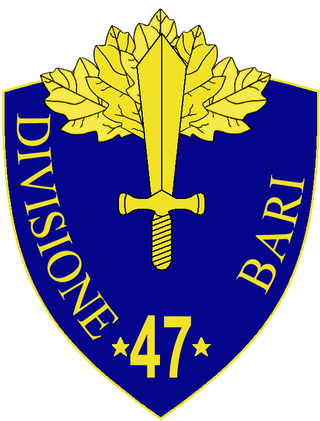
The 47th Infantry Division "Bari" was an infantry division of the Royal Italian Army during World War II. The Bari was formed on 15 September 1939 in the city of Bari. After the announcement of the Armistice of Cassibile on 8 September 1943 the division became part of the Italian Co-belligerent Army. On 21 September 1944 the division was reorganized as Internal Security Division "Aosta". The Bari drafted its men in Bari and the surrounding Salento region.
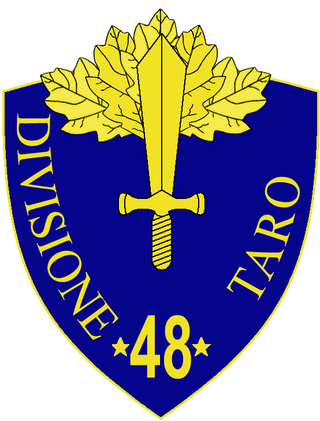
The 48th Infantry Division "Taro" was an infantry division of the Royal Italian Army during World War II. The Taro was formed on 12 September 1939 in Catanzaro and named for the river Taro. After the Armistice of Cassibile the division disbanded on 8 September 1943 in Toulon, France.
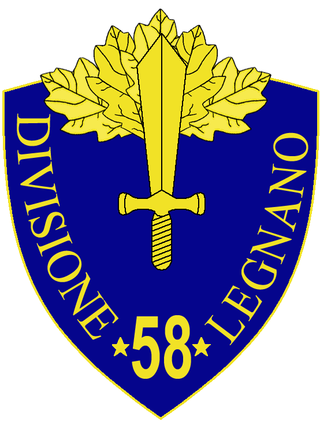
The 58th Infantry Division "Legnano" was an infantry division of the Royal Italian Army during World War II. The Legnano's predecessor division was formed on 8 February 1934 in Milan and named for the medieval Battle of Legnano. On 24 May 1939 the division split to form the 6th Infantry Division "Cuneo" and the 58th Infantry Division "Legnano". After the announcement of the Armistice of Cassibile the Legnano resisted the invading German forces. The division's staff and 67th Infantry Regiment "Legnano" were used to form the first unit of the Italian Co-belligerent Army, which fought on the allied side in the Italian campaign. On 17 February 1944 the division's last units joined other commands and the division was officially dissolved.

The 49th Infantry Division "Parma" was an infantry division of the Royal Italian Army during World War II. The Parma was activated on 12 September 1939 in Macerata and named for the city of Parma. After the announcement of the Armistice of Cassibile on 8 September 1943 the division was disbanded by German forces in Vlorë in Albania.

The 50th Infantry Division "Regina" was an infantry division of the Royal Italian Army during World War II. The Regina was formed on 1 March 1939 in the Italian Islands of the Aegean and entitled to the Queen. After the announcement of the Armistice of Cassibile between Italy and the Allies on 8 September 1943 the division fought Wehrmacht forces in the Battle of Rhodes. The majority of the division surrendered on 11 September 1943, while the III Battalion, 10th Infantry Regiment "Regina" resisted the Germans on Leros until 16 November 1943.

The 51st Infantry Division "Siena" was an infantry division of the Royal Italian Army during World War II. The Siena was formed on 15 September 1939 and named for the city of Siena. The division was a Campanian unit and its men were almost entirely from Naples. After fighting in the Greco-Italian War the division was sent to Crete as garrison unit. There the division was disbanded by invading German forces after the Armistice of Cassibile was announced on 8 September 1943.

The 53rd Infantry Division "Arezzo" was a infantry division of the Royal Italian Army during World War II. The Arezzo was classified as a mountain infantry division, which meant that the division's artillery was moved by pack mules instead of the horse-drawn carriages of line infantry divisions. Italy's real mountain warfare divisions were the six alpine divisions manned by Alpini mountain troops.

The 151st Infantry Division "Perugia" was an infantry division of the Royal Italian Army during World War II. The Perugia was formed on 25 August 1941 and named for the city of Perugia. The Perugia was classified as an occupation infantry division, which meant that the division's artillery regiment consisted of two artillery groups instead of the three artillery groups of line infantry divisions and that the divisional mortar battalion was replaced by a divisional machine gun battalion.
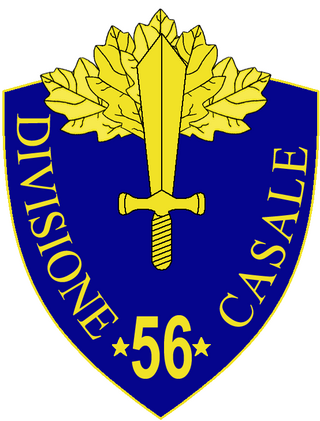
The 56th Infantry Division "Casale" was an infantry division of the Royal Italian Army during World War II. The Casale was activated on 15 June 1939 in Forlì and named for the city of Casale Monferrato and recruited most its men from the Romagna region. The division was sent to Greece as occupation and force. There the division was disbanded by invading German forces in the Aetolia-Acarnania region of Greece after the announcement of the Armistice of Cassibile on 8 September 1943.

The 154th Infantry Division "Murge" was an infantry division of the Royal Italian Army during World War II. The Murge was formed on 1 December 1942 and named for the Murge plateau in Apulia. The Murge was classified as an occupation infantry division, which meant that the division's artillery regiment consisted of two artillery groups instead of the three artillery groups of line infantry divisions and that the divisional mortar battalion was replaced by a divisional machine gun battalion. The division was sent to Herzegovina as an occupation force, where it took part in anti-partisan operations. It took part in the Battle of the Sutjeska and then had to be withdrawn after suffering heavy losses. It was disbanded in September 1943, following the announcement of the Armistice of Cassibile.

The 48th Infantry Regiment "Ferrara" is an inactive unit of the Italian Army last based in Bari. The regiment is named for the city of Ferrara and part of the Italian Army's infantry arm. On 2 July 1859, during the Second Italian War of Independence, a mobile column was formed with volunteers in Bologna. The column did not see action in the war and was soon split into two columns. On 1 October 1859, the 2nd Mobile Column was renamed 26th Infantry Regiment and assigned, together with the 25th Infantry Regiment, to the Brigade "Ferrara" of the Army of the League of Central Italy of the United Provinces of Central Italy. On 1 January 1860, the 26th Infantry Regiment was renumbered 48th Infantry Regiment, and on 25 March 1860, the regiment joined the Royal Sardinian Army.

The 47th Infantry Regiment "Ferrara" is an inactive unit of the Italian Army last based in Capua. The regiment is named for the city of Ferrara and part of the Italian Army's infantry arm. On 2 July 1859, during the Second Italian War of Independence, a mobile column was formed with volunteers in Bologna. The column did not see action in the war and was soon split into two columns. On 1 October 1859, the 1st Mobile Column was renamed 25th Infantry Regiment and assigned, together with the 26th Infantry Regiment to the Brigade "Ferrara" of the Army of the League of Central Italy of the United Provinces of Central Italy. On 1 January 1860, the 25th Infantry Regiment was renumbered 47th Infantry Regiment, and on 25 March 1860, the regiment joined the Royal Sardinian Army.




















